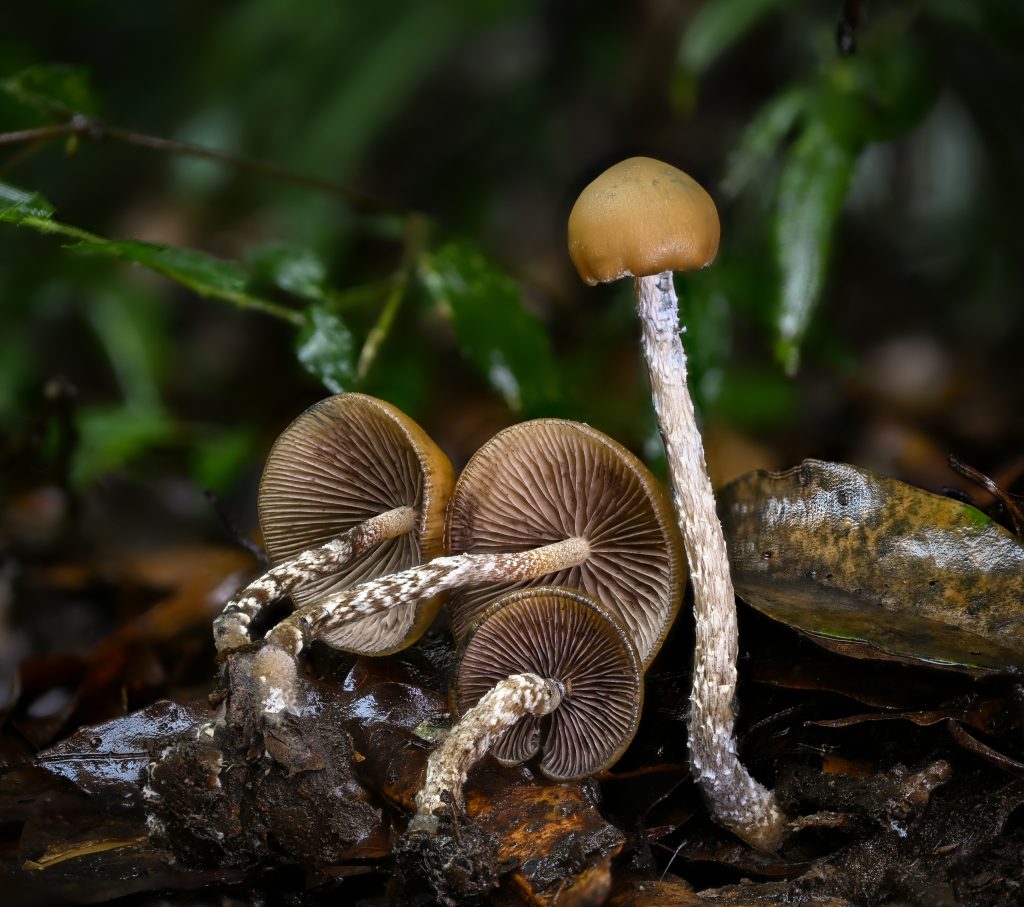Psilocybe zapotecorum[i], also known as zap, is a relatively large psychoactive mushroom from Central and South America. It is said to have been used traditionally by the Zapotec people, for whom the species was named. While it’s use is not common among non-Zapotec psychonauts, it’s not unheard of, either. It’s available for those who want it, and it compares well to cubes.
Identification and Description
Zaps are big, as Psilocybes go, with medium to large caps and long, slender stems. The cap is often asymetrical and can be irregular in shape. Though the basic color is yellow-brown with a paler, sometimes white stem, but zaps blue easily and can become almost black.
Within their range, zaps often grow in wet forests and marshes. They fruit in groups, sometimes very large groups.
Look-Alikes
Zaps at least vaguely resemble a great many other mushrooms, including the aptly-named Deadly Galerina, although zaps are typically bigger than most of their look-alikes. The closest resemblance may be to P. caerulescens, and P. angustipleurocystidiata, but few if any of these occur in the same habitat.
Effects
The effects of zaps are similar to those of cubes—reportedly there are some qualitatively differences from the typical cube, but not more than cube strains are said to vary from each other. Essentially, zaps deliver psilocybin and therefore have the effects of psilocybin.
Psilocybin alters emotional tone, cognitive style, and perception. That last is the most famous among people who don’t use psilocybin—many of whom will describe the substance simply as a hallucinogen, as if it didn’t do anything else. Actually, psilocybin doesn’t cause hallucinations at microdoses, and the visions are usually fairly subtle even at moderate doses. Cognitive changes are more valuable for many users, as these can bring important personal and spiritual insights. Emotionally, psilocybin usually brings euphoria and feelings of connectedness, though sometimes not—it’s often said that what psilocybin really does is exaggerate whatever emotions the user brings to the experience, which is why establishing a mindset worth exaggerating is so important.
The effects don’t turn on instantly upon munching a mushroom but instead develop gradually towards a peak, then gradually taper off. The whole experience usually takes a number of hours followed by a day or more for recovery and reflection.
Potency and Dosage
There is never just one dose size for psychoactive mushrooms—it all depends on what kind of experience the user wants. Many writers definite five types of dose, ranging from a microdose (which is not hallucinogenic) all the way up to a heroic dose (which can result in temporary ego-death and is potentially dangerous). For any give type of dose, the user takes a larger or smaller amount. depending on the potency of the mushroom in question.
Unfortunately, for zaps, potency is extremely variable, characterized as anything from moderate to very high. There is thus no way to write a definitive dosage guideline for this species. Since an unexpectedly high dose could lead to unpleasant, even dangerous side-effects, it’s important to be cautious with variable mushrooms.
One option is to assume your zaps are high-potency and measure out a small dose accordingly—then take more if necessary. Another option is to to get enough for many doses, then dry, powder, and mix the mushrooms. You can then use cautious trial and error to establish a minimum dose size. Then use this minimum dose as the basis for measuring out the right about for the trip you want.
Growing
Zaps are not difficult to cultivate, and although spores can be hard to find, they are out there. Generally speaking, the methods developed for cubes will also work for zaps, although the details may need to be fine-tuned for best results[ii]. Fruiting temperature should ideally be in the low to mid seventies—higher temperatures will cause more aborts. Colonization time and fruiting time should be in the same range as with cubes. Do remember that zaps average larger and will therefore need more head-room in which to fruit.
Toxicity, Safety, & Side Effects
Zaps are not known to have any safety issues beyond those of most other Psilocybes—which is to say there are safety issues, but risk can be minimized by following some basic safety guidelines.
The side effects of using zaps are the side effects of psilocybin. The most common of these are minor, such as nausea or excessive yawning. Trouble with balance is a little more serious, but poses few problems if the psychonaut avoids walking around. Anxiety, which can be debilitating, is a real concern, but can be avoided by carefully preparing a safe, mellow setting and a calm, trusting mindset, and by having a sober trip-sitter present able to provide support if needed. A trip-sitter can also be helpful if something needs to be done that tripping makes difficult or dangerous—such as driving or handling an important but unexpected phone call.
Dangerous side-effects, including convulsions, are very rare, but possible. Whether serious psychological damage is a real risk seems unclear, but it certainly is possible.
All side-effects, including the dangerous ones, are more likely at higher doses, especially unexpectedly high doses. It’s important therefore to take the smallest amount necessary to get the experience you’re looking for, and to not take high doses without adequate prior experience and preparation.
Of course, in many jurisdictions, the most dangerous risks associated with psilocybin use involve the law.
References:
[i](n.d.). Psilocybe zapatecorum. Psillow
[ii]Hindsight (2023). Official Psilocybe zapetecorum Thread. Shroomery



